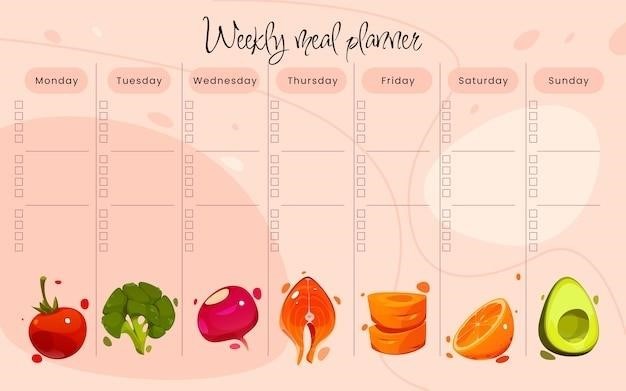Understanding the Low GI Diet
The Glycemic Index (GI) measures how quickly carbohydrates in food raise blood sugar levels. A low GI diet emphasizes foods that release glucose slowly‚ promoting sustained energy levels and better blood sugar control. This approach to weight loss focuses on long-term‚ sustainable changes rather than quick fixes‚ leading to gradual and lasting results.
What is the Glycemic Index (GI)?
The Glycemic Index (GI) is a scale that ranks carbohydrates based on how quickly they raise blood sugar levels after eating. Foods with a high GI are quickly digested and absorbed‚ causing a rapid spike in blood sugar. Conversely‚ low GI foods are digested and absorbed more slowly‚ resulting in a gradual rise in blood sugar levels. This slower release of glucose provides sustained energy‚ promotes satiety‚ and helps regulate blood sugar levels‚ which is particularly beneficial for individuals with diabetes or those looking to manage their weight.
Benefits of a Low GI Diet for Weight Loss
A low GI diet offers several advantages for weight loss. By promoting gradual glucose release‚ it helps regulate blood sugar levels‚ reducing cravings and promoting satiety. This can lead to a reduction in calorie intake‚ as you feel fuller for longer. Additionally‚ low GI foods tend to be rich in fiber‚ which further aids digestion and promotes a feeling of fullness. The sustained energy levels provided by low GI foods can also boost your metabolism and increase your overall activity levels‚ contributing to weight loss. Furthermore‚ a low GI diet may help improve insulin sensitivity‚ which can enhance the body’s ability to utilize glucose effectively‚ reducing fat storage and promoting weight management.

The 12-Week Low GI Weight Loss Plan
This comprehensive program guides you through three phases‚ each with specific strategies and meal plans designed to achieve sustainable weight loss and healthy habits.
Phase 1⁚ Initial Weight Loss (Weeks 1-4)
This phase focuses on rapid weight loss by strictly adhering to the low GI principles. You’ll prioritize low-GI foods‚ such as whole grains‚ legumes‚ and lean protein sources. This phase emphasizes portion control and mindful eating‚ helping you develop a better understanding of your body’s hunger cues. Regular physical activity is crucial during this phase to enhance calorie expenditure and improve overall well-being. While this phase is designed for initial weight loss‚ it’s essential to remember that sustainable weight management requires long-term commitment and gradual adjustments to lifestyle habits.
Phase 2⁚ Maintaining Weight Loss (Weeks 5-8)
This phase focuses on maintaining the weight loss achieved in Phase 1 while gradually introducing more variety and flexibility into your diet. You’ll continue to prioritize low-GI foods‚ but now you can incorporate some higher-GI options occasionally‚ like fruits and starchy vegetables. This phase emphasizes building healthy habits and finding sustainable ways to manage your weight. You might start incorporating enjoyable activities that promote physical activity‚ such as dancing‚ hiking‚ or swimming. Remember that maintaining weight loss is a lifelong journey that requires continuous effort and adjustments to your lifestyle.
Phase 3⁚ Sustaining Healthy Habits (Weeks 9-12)
This phase focuses on solidifying the healthy habits you’ve developed during the previous phases. You’ll continue to make mindful food choices‚ prioritizing low-GI foods and incorporating some higher-GI options in moderation. You’ll also maintain your regular physical activity routine‚ finding activities you enjoy and can sustain long-term. You’ll be able to identify your body’s cues for hunger and fullness‚ allowing you to make better choices and avoid overeating. This phase is about building confidence in your ability to manage your weight sustainably and integrating healthy habits into your daily life. You’ll have a clear understanding of the power of food choices and the importance of regular physical activity. Remember‚ weight management is an ongoing process‚ and this phase sets you up for long-term success.
Sample Low GI Meal Plan
This meal plan provides examples of low-GI meals that can be adapted to your individual preferences and dietary needs. It is designed to provide balanced nutrition and promote sustained energy throughout the day.
Breakfast
Starting your day with a low-GI breakfast sets the tone for sustained energy levels throughout the morning. A good low-GI breakfast option is a bowl of oatmeal with berries and nuts. Oatmeal is a whole grain with a low GI‚ providing sustained energy release. Berries are rich in antioxidants and fiber‚ contributing to a feeling of fullness. Nuts add healthy fats and protein‚ further promoting satiety. This combination ensures a well-balanced breakfast that keeps you feeling energized and satisfied until lunch.
Another delicious low-GI breakfast option is a whole-wheat toast with avocado and poached eggs. Whole-wheat bread provides fiber and complex carbohydrates‚ while avocado is a good source of healthy fats and fiber. Poached eggs add protein‚ contributing to a feeling of fullness. This combination provides a satisfying and nutritious start to your day‚ promoting sustained energy and supporting your weight loss journey.
Lunch
Lunch is a crucial meal for maintaining energy levels and keeping hunger at bay throughout the afternoon. A low-GI lunch should be balanced and satisfying‚ providing a good mix of protein‚ fiber‚ and healthy fats. A great option is a salad with grilled chicken or fish‚ topped with a light vinaigrette dressing. Leafy greens provide essential vitamins and minerals‚ while grilled protein offers lean protein for satiety. A light vinaigrette dressing‚ made with olive oil and vinegar‚ adds flavor without excessive calories or unhealthy fats.
Another satisfying low-GI lunch option is a lentil soup with whole-wheat bread. Lentils are a high-protein‚ high-fiber legume with a low GI‚ promoting sustained energy and feelings of fullness. Whole-wheat bread provides complex carbohydrates and fiber‚ further contributing to a balanced meal. This combination offers a warm and comforting lunch that is both nutritious and satisfying.
Dinner
Dinner is the final meal of the day and should be a satisfying and nourishing experience. A low-GI dinner should focus on lean protein sources‚ fiber-rich vegetables‚ and whole grains. Grilled salmon with roasted vegetables is a delicious and healthy option. Salmon is packed with omega-3 fatty acids‚ which are beneficial for heart health and brain function. Roasted vegetables like broccoli‚ Brussels sprouts‚ and asparagus provide fiber and essential vitamins and minerals.
Another satisfying low-GI dinner is a lentil and vegetable curry served over brown rice. Lentils are a versatile and protein-rich legume with a low GI‚ contributing to a filling meal. The curry sauce can be made with a variety of vegetables‚ such as onions‚ carrots‚ and tomatoes‚ adding flavor and nutrients. Brown rice provides complex carbohydrates and fiber‚ contributing to a balanced and satisfying meal. These options provide a variety of flavors and textures‚ ensuring that the low-GI diet can be both healthy and enjoyable.
Tips for Success
Embarking on a low GI diet requires dedication and a commitment to making sustainable lifestyle changes. It’s not just about the food you eat‚ but also about building healthy habits that support your weight loss journey.
Stay Hydrated
Water plays a crucial role in weight loss and overall health. It helps to curb hunger pangs‚ boost metabolism‚ and flush out toxins. Staying hydrated is especially important on a low GI diet as it can help to regulate blood sugar levels and prevent energy crashes. Aim to drink plenty of water throughout the day‚ especially before meals. You can also incorporate other hydrating beverages like herbal teas and unsweetened fruit infusions. Remember that sugary drinks can sabotage your efforts‚ so stick to water and other low-calorie options.
Listen to Your Body
While a structured plan can be helpful‚ it’s crucial to listen to your body’s signals. Pay attention to your hunger cues and fullness levels. Don’t force yourself to eat if you’re not genuinely hungry‚ and stop eating when you feel comfortably satisfied. If you experience any unusual symptoms or discomfort‚ consult with a healthcare professional or registered dietitian. They can provide personalized guidance and ensure that your weight loss journey is safe and effective. Remember‚ every individual is different‚ and what works for one person may not work for another.
Seek Professional Guidance
While the 12-week low GI weight loss plan offers a structured approach‚ it’s always advisable to seek guidance from a qualified healthcare professional or registered dietitian. They can assess your individual needs‚ medical history‚ and dietary preferences to create a personalized plan that aligns with your goals and helps you achieve sustainable weight loss. Their expertise can ensure that your diet is balanced‚ nutrient-rich‚ and safe for your body. They can also address any concerns you may have about the plan and provide support throughout your weight loss journey. Remember‚ a collaborative approach with a professional can maximize your chances of success and ensure a healthy‚ sustainable transformation.
The 12-week low GI weight loss plan provides a comprehensive framework for sustainable weight management‚ promoting gradual‚ healthy changes for long-term success.
The Power of a Balanced Approach
The low GI diet isn’t just about restricting certain foods; it’s about making informed choices to create a balanced and sustainable eating pattern. By focusing on nutrient-rich‚ low GI foods‚ you provide your body with the energy it needs while promoting steady blood sugar levels. This approach goes beyond simply shedding pounds; it fosters a healthier relationship with food and a deeper understanding of how your body responds to different dietary choices. The 12-week plan emphasizes gradual adjustments‚ allowing your body to adapt and develop healthier habits over time. This balanced approach not only supports weight loss but also contributes to overall well-being‚ reducing the risk of chronic diseases associated with unhealthy eating patterns.
Embracing a Sustainable Lifestyle
The 12-week low GI weight loss plan isn’t just a temporary diet; it’s a roadmap to a healthier‚ more sustainable lifestyle. As you progress through the phases‚ you’ll gain valuable insights into your body’s responses to different foods and learn how to make informed choices that support your well-being. By embracing the principles of the low GI diet‚ you’ll cultivate a mindful approach to eating that goes beyond calorie counting and promotes long-term health. The plan emphasizes building a balanced relationship with food‚ incorporating regular physical activity‚ and prioritizing overall well-being. This holistic approach empowers you to make lasting changes that contribute to both physical and mental health‚ setting you on a path towards a healthier and happier you.
